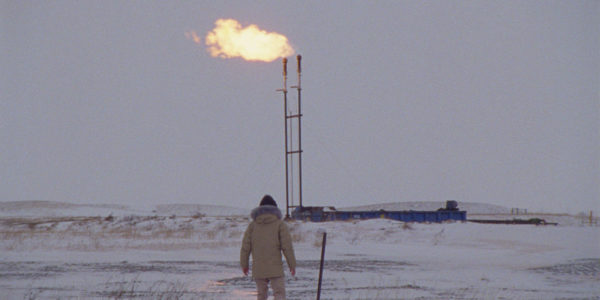
There’s an economy of storytelling to How To Blow Up a Pipeline, which wastes no time jumping right into the meat of the story.
The opening of the film finds its group of eight diverse leads coordinating their schedule via burner cell phones, abandoning their day jobs as cleaners or store clerks, and hitting the road.
The destination is West Texas, where Xochitl (Ariela Barer), Shawn (Marcus Schribner), girlfriends Theo (Sasha Lane) and Alicia (Jayme Lawson), cowboy Dwayne (Jake Weary), Indigenous Michael (Forrest Goodluck), and misfit couple Logan (Lukas Gage) and Rowan (Kristine Froseth) meet up in a desolate, run down house to begin building bombs.
How To Blow Up a Pipeline is based on a nonfiction book of the same name by Andreas Malm. The book advocates for destructive activism to combat environmental threats by capitalist fossil fuel companies. This rhetoric is routinely espoused by the film’s characters, particularly Xochitl and Theo (the defacto ringleaders); the argument is that passive activism such as protests and food banks, which is something Alicia advocates for, don’t have the same direct impact as direct action against pipelines that will disrupt the supply chain and drive up market costs. Even while the group recognizes the direct impact that their explosive plan will have on everyday individuals and that they will be branded terrorists if their plan succeeds, they believe that the end justifies the means.

How to Blow Up a Pipeline is a marvel if only because many of its eight protagonists remain something of a mystery throughout the film. Nearly everyone gets their own title card and (brief) backstory that details how and why they ended up in West Texas. These reasons range from the death of a parent (Xochitl) or contracting an illness (Theo) due to living too close to poison-spewing factories, losing employment opportunities (Michael) or land to “imminent domain” so that a pipeline can built (Dwayne), or other external forces (Rowan and Logan).
Regardless of the individual reasons, the film is laser focused on one specific plan that unfolds over a period of roughly 24 hours: blow up a Texas pipeline, without hurting anyone and without causing permanent environmental damage. The audience learns just enough to know and understand why the group is driven to such drastic, violent measures and then the ticking clock kicks in.
This expedient form of storytelling is surprisingly effective: with the plan in motion, How to Blow Up a Pipeline effectively becomes a heist film set to a bombastic, propulsive techno soundtrack (courtesy of Gavin Brivik). And like every heist film, there are the inevitable complications and setbacks that ramp up the tension, threaten the success of the mission, and endanger the characters’ safety.

Written by star Ariela Barer, Jordan Sjol and director Daniel Goldhaber (who also edits), How to Blow Up a Pipeline is incredibly tense and provocative. The film grimly makes its argument, then demands that audiences invest in the success of the mission, even as we wait for things to go pear shaped (because nothing ever goes according to plan). It doesn’t hurt that the film is incredibly well-paced, compellingly acted, and slickly produced.
Goldhaber proved his mettle for directing tense set pieces with 2018’s horror doppelganger film Cam and despite exchanging the bisexual lighting for a more low-key dry, dusty desert aesthetic (courtesy of production designer Adri Siriwatt), both films share Goldhaber’s keen ability to shoot and edit to create maximum tension.
Take, for example, a key sequence when the character debate the statistical odds of blowing themselves up with highly combustible materials, which is followed moments later by an explosion, which is immediately interrupted by a cut to a title card and backstory to draw out and delay the reveal of whether someone has been grievously injured or killed. It’s a masterclass of using editing to tell a story, and it’s exceptional.
How to Blow Up a Pipeline is an essential, timely, and (forgive the pun) incendiary tour de force. The performances are great, particularly Barer, Lane, and a quietly standoffish Goodluck. With his second slam dunk, Goldhaber cements his status as a director to watch. How to Blow Up a Pipeline is a great, provocative film. Don’t sleep on it. 4.5/5
How to Blow Up a Pipeline is in theaters April 7